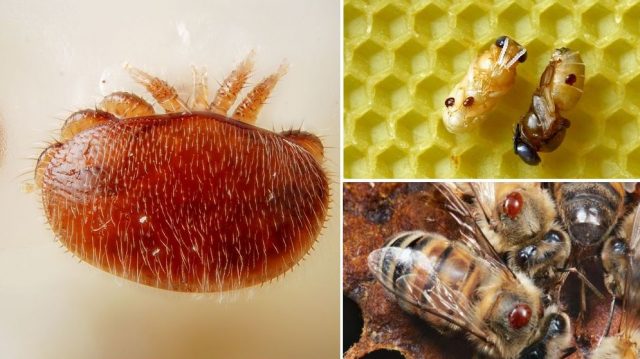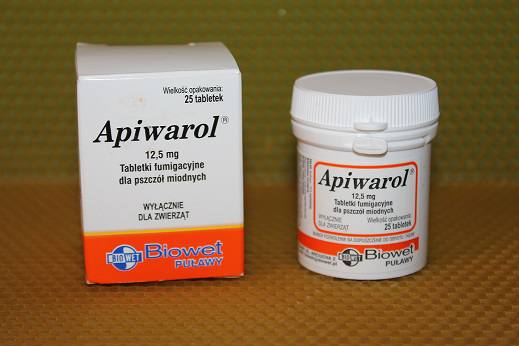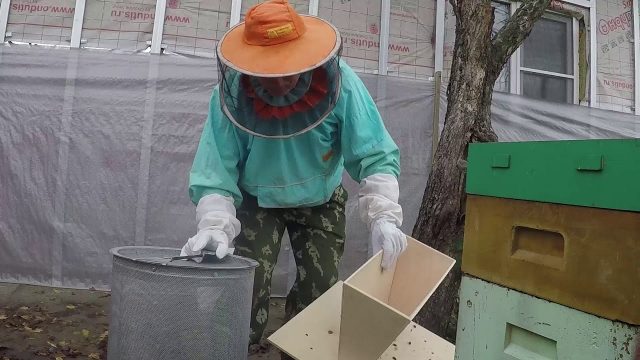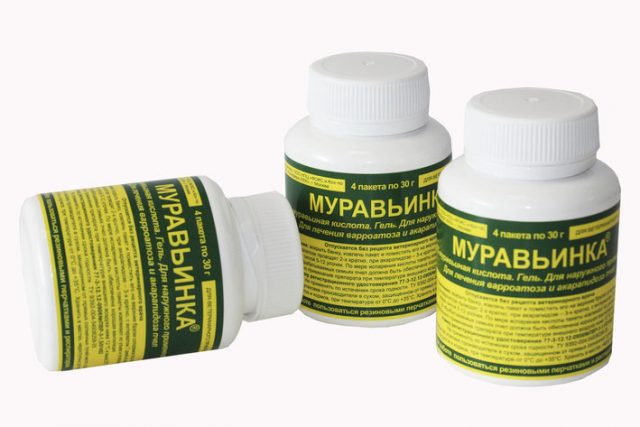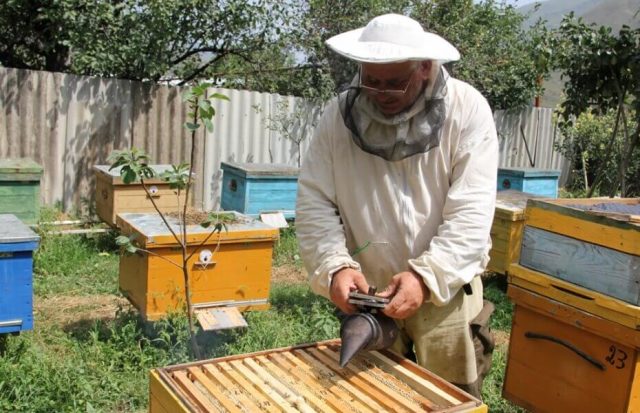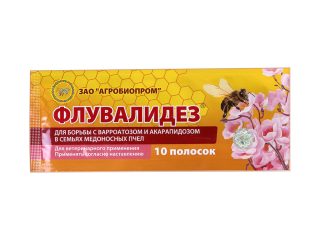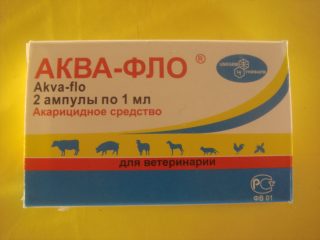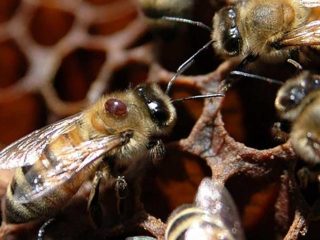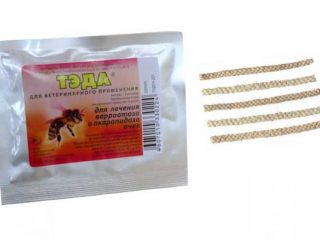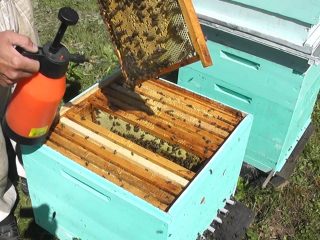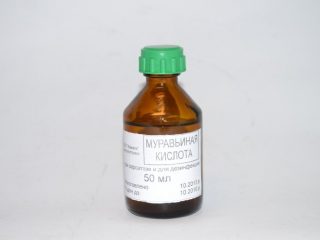Content
- 1 What is varroatosis
- 2 Signs of varroatosis in bees
- 3 The right time to treat varroatosis bees
- 4 Treatment options for varroatosis
- 5 How to treat bees from a tick in summer
- 6 Autumn treatment of bees from varroatosis
- 7 Prevention measures
- 8 Conclusion
Of all the plagues that honeybees are exposed to, tick infestation is the most insidious. These small parasites appear in the hive suddenly and provoke many dangerous diseases, and therefore the timely treatment of bees in the fall from ticks is a necessary procedure for both professionals and amateur beekeepers.
What is varroatosis
Varroatosis is a non-infectious disease caused by the Varroa Jacobsoni mite. This parasite infects brood or adult bees and feeds on their hemolymph, which leads to the appearance of anatomical anomalies in insects and even to their death. For the first time, this disease was recorded only in Indian bees, but then, starting in the 60s of the last century, it spread throughout the world.
Varroatosis is considered a very dangerous ailment, since it not only reduces the efficiency of the entire bee family, but can also destroy the entire apiary in the absence of timely treatment and competent processing.
Life cycle of the Varroa mite
Once in the hive, the female tick enters the cell with the drone or bee brood shortly before sealing and begins to intensively feed on the food intended for the larva. Then she lays one unfertilized egg, from which a male Varroa hatches after 6 days, and several fertilized ones, from which young females appear in a day. Here, in the cell, the male fertilizes the females and dies. Female ticks are fixed on the bee pupa and feed on its hemolymph. After the brood leaves the combs, the mites crawl into the next cells, resuming the breeding cycle.
Often they cling to adult bees, piercing the chitinous shell of insects in the area of the neck and abdomen junction. An infected bee or larva can be distinguished from a healthy one without the use of special devices, since a round shiny brown formation with a diameter of 1 - 2 mm will be noticeable on it.
How does the infection take place
Infection with bee varroatosis occurs for a number of reasons:
- Varroa mites tend to detach from bees during the pollen collection period and wait for a new host for 5 days, hiding in the grass or flowers, so they are often brought by worker bees at the end of the honey harvest.
- The parasite in the hive can be carried by thief bees infected with varroatosis or by flying drones.
- Promotes the spread of the disease and the movement of frames with the affected brood of bees from one hive to another.
- Relocation of a bee colony affected by a tick to a healthy community can also cause signs of varroatosis.
Signs of varroatosis in bees
Since ticks feed on brood food during the breeding season, the larvae often do not have enough food during development. For this reason, bees with varroatosis often come out of the brood without wings or with other abnormalities, such as:
- small size;
- deformed abdomen;
- asymmetrical wings;
- the absence of several legs.
Many larvae die right in the cells, due to which the caps on them become concave or acquire a rotten smell. Adults, on the other hand, behave restlessly, do not participate in honey collection and are passive in the affairs of the hive.
Degrees of defeat
As a rule, 3 stages of varroatosis manifestation are observed:
- the defeat of bees by a tick reaches 10%;
- mite infestation of bees reaches 20%;
- infestation of bees by a tick reaches 40% and more.
In the first case, if the bee colony has still functioned without interruptions, it may well live with the disease, requiring minimal processing by the beekeeper. However, in the second and third cases, it is necessary to immediately begin treatment and treatment in order to preserve the health and functionality of the bees.
Laboratory diagnostics
The effectiveness of treatment for varroatosis of bee colonies infected with a tick directly depends on the timing of diagnosis. A timely diagnosis will prevent further spread of the disease. However, the degree of infection can only be detected in laboratory conditions.
For analysis, take about 200 g of dead bees and litter from the hive, and, depending on the season, samples of brood, honeycomb and live insects. So, in spring, a brood with a honeycomb of 3x15 cm is sent for research, in summer and autumn drone brood or 100 live insects are taken, which are transported in glass jars tied with gauze in 2 - 3 layers. It is better to transport brood and combs in boxes made of plywood or wood, positioning the frames so that they do not touch the walls.
The right time to treat varroatosis bees
Treatment for combating varroatosis of bees should be started in the fall, in particular, before the hive wintering. As a rule, honey is pumped out during this period, which means that the tick will have much less food. This significantly reduces the chances of mites reproducing. At this point, the remaining brood also emerges from the combs, and during treatment and processing, the risk of harming the larvae will be minimal. In addition, ticks on adult insects will not be able to spread through the apiary, since honey collection has already been completed.
However, it often happens that varroatosis occurs in the spring and progresses rapidly. In this situation, delay in treatment can be fatal for the bees. Therefore, when choosing a means for treating bees from ticks, it is necessary to take into account the time of year.
Treatment options for varroatosis
Treatment of bees for varroatosis is carried out in several ways:
- chemical;
- physical;
- using folk methods of processing.
The choice of treatment method depends on the season during which the treatment is carried out. However, these methods do not completely eliminate the tick and can only reduce the number of parasites. At the same time, the most significant results are observed when several methods of treating varroatosis are combined.
What can be given to bees from ticks?
Today, almost all commercially available drugs for the treatment of varroatosis contain 4 types of active substances:
- amitraz;
- bromopropylate;
- chlorobenzylate;
- fluvalinate.
On their basis, water solutions and strips from mites are made from polymer or wood with appropriate impregnation. Among the latter, Folbex is especially popular.
Folbex Is a preparation for treatment against a tick of foreign production, in one pack of which there are 50 cardboard strips impregnated with 400 mg of chlorobenzylate. They use it in spring and summer. In the morning or in the evening, the strips are fixed on the frame, where the honeycomb is not located, placed in the center of the nest and set on fire. 2 strips are enough for 1 hive of 16 frames. Folbex treatment is stopped 30 days before the main honey collection by removing the frame from the hive.
A very common drug in the treatment of ticks is Bipin, which contains amitraz. It is available in glass ampoules of 1 or 0.5 ml and has a high concentration, so before processing it must be diluted with water, carefully following the instructions on the package. A solution of this medicine has a strong unpleasant odor. It must be used immediately after preparation. The prepared product is poured into the space between the frames at the rate of 10 ml per 1 street. For 1 family, from 50 to 150 ml is consumed, depending on how strong it is. Processing is carried out in the fall during the formation of the club - 2 times with a break of 1 week.
Apitak - another medicine containing amitraz - is also used in the form of a solution due to its strong concentration. For this, 1 ampoule of 0.5 ml is diluted in 1 liter of warm water. Apply it in the same amount as bipin, spreading the liquid with a syringe or measuring bottle. If the results are unsatisfactory, the treatment can be repeated after 7 days.
In addition to solutions and tick strips, smoldering tablets, for example, Apivarol, are in considerable demand. Often, 1 brown pill is enough to treat an entire family of bees. The medicine should be set on fire and extinguished as soon as fire appears. At the same time, smoke begins to stand out with an anti-varroatous substance, in this case - amitraz, which destroys the tick. For greater effect, the tablet should be placed in the center of the nest and closed for 20 minutes. Repeat the course of treatment if necessary after 5 - 7 days.
Although chemical methods of treatment are quite effective in combating varroatosis, varroa mites tend to adapt to substances in veterinary drugs within 2 to 3 years. Therefore, it is recommended to change synthetic medicines every season, combining them with physical treatment or with folk recipes.
Treatment of bees from varroatosis without chemistry
The method of physical influence implies the absence of chemicals in the process of treating varroatosis. Instead, the infected bee colony is heat treated or magnetically treated.
Heat treatment is based on the difference in sensitivity of bees and varroa mites to high temperatures. The former tolerate heat much better, while ticks die quickly if conditions do not correspond to the 25 - 35 ° C range.
For processing, choose the morning or evening hours, when all insects are present in the nest. Frames with bees are moved to a heat chamber, where temperature readings are set up to 46 ° C. In this case, the queen bee is located separately from the rest of the family. After 15 - 20 minutes, the mites fall off the bees, after which the insects are returned to the hive.
A similar remedy for treating bees from varroatosis is usually practiced in the fall, when all the mites are on adult insects. And although this method of treating varroatosis has its supporters, it is quite risky, since it poses a danger not only to the tick, but also to the bees.
Magnetic processing is less dangerous in this regard.It requires the installation of 2 powerful magnets in the area of flight activity of bees, for example, near the entrance or the arrival board. The magnets do no harm to the bees, but they disorient the mites, which leads to their shedding. Special mesh traps will help prevent them from returning to the hive.
Treatment of bees from varroatosis with folk remedies
Among other drugs for the treatment of Varroa mite, sophisticated beekeepers prefer folk remedies as a safer and more organic alternative to chemical treatment. This helps to prolong the life of bees and preserve the natural properties of honey and other beekeeping products.
Celandine against varroatosis
Many beekeepers in the fight against the Varroa mite note the effectiveness of celandine, although its positive effect has not been scientifically proven to date. For the preparation of the drug, flowers and the green part of the plant are often used, however, the rhizome is also suitable for treating a tick. Before use, the grass is thoroughly dried, making sure that it does not fall on direct sunlight. A decoction is prepared from dry raw materials according to the following recipe:
- 100 g of fresh or 50 g of dried celandine is poured into 1 liter of boiling water.
- Boil plant materials for 3 minutes over medium heat.
- After that, the finished product is insisted for at least 30 minutes.
The resulting broth should be sprayed on bees, brood and frames 3 - 5 times with a break of 6 - 7 days between treatments. Such a remedy is used not only in the treatment of varroatosis, but also in the prevention of such ailments as foulbrood and nosematosis.
Fir oil
Fir oil has proven to be effective and completely harmless against ticks. Treatment of varroatosis with fir oil is carried out as follows:
- Take a sheet of parchment, the size suitable for the bottom of the hive, and grease with essential oil in the amount of 1 - 2 ml per 1 family.
- After that, the sheet is placed over the frames with the oiled side down and covered with a canvas. In this case, the entrances are closed for 1 - 2 hours.
- Then the entrances are reopened and the parchment is left for another 72 hours. During this time, some of the mites will crumble to the bottom of the hive, so it will be useful to place a trap mesh there.
This method of treating bees for varroatosis is carried out 3 times in the summer and 2 times in the fall and spring, with an interval of 8-10 days. The optimum temperature for mite treatment is +14 - +30 ° C.
Sugar syrup with herbs
With varroatosis, it will be useful to treat bees with sugar syrup, to which infusions of calendula, chamomile or motherwort flowers are added:
- 50 g of dry weight of the plant is added to 1 liter of cold water.
- Cook the workpiece on a steam bath for 30 minutes, then another 15 minutes. after boiling.
- Within 30 min. the broth is allowed to cool, filtered and combined with syrup at the rate of 50 - 100 g per 1 liter.
Infusion of bitter pepper
An equally effective medicine in the treatment of varroatosis is an infusion of red capsicum:
- 50 - 60 g of dried peppers should be cut into 1 cm pieces and placed in a thermos.
- Then pour 1 liter of boiling water, seal it tightly and leave for 15 - 20 hours.
- After that, the infusion should be filtered without spinning.
Pepper infusion is used for processing frames with bees and brood, walls and bottom of the hive, spraying surfaces with "Rosinka". In this way, it is necessary to treat bees from varroatosis 3-4 times with a break of 7 to 8 days in the spring, after honey pumping and in the fall, when the last brood emerges.
Formic acid
Formic acid has also been shown to work well against bee varroatosis.As a rule, technical formic acid of grades A, B and analytical grade is used in the treatment of this ailment, whose concentration is 86.5 - 99.7%. Most often, strips of cardboard 20-25 cm long are impregnated with this tool, after which they are wrapped in plastic bags to size and closed, bending the upper edge 2 times. Then a couple of holes with a diameter of 1.5 cm are made in them, they are placed on the frames at the top of the nest so that the holes are at the bottom. 2 slats are placed under the bags and left for 20 - 25 days. The method of processing formic acid in vials is also quite effective, however, it is worth using this drug in any form with caution, since its high concentration can harm bees.
The treatment for ticks is carried out in the spring after the flight 1 week before the main honey collection and at the end of the summer after the extraction of honey.
Pine flour
Coniferous flour, which is a powder from the needles of various tree species, is very useful in the treatment of varroatosis. Bees and honeycombs are sprinkled with such flour when using a gauze bag. For 1 bee colony, 40-50 g of such a medicine is enough. The treatment is repeated three times with a frequency of 1 time in 7 days. The effect is noticeable already after 12 hours: ticks begin to die en masse, as they do not tolerate the active substances contained in the needles.
Treatment of bees from varroatosis with wormwood
A popular remedy for eliminating the Varroa mite is the wormwood infusion:
- 500 g of dry plant mass is poured with 10 liters of boiling water.
- Then the vessel with the liquid is covered with a dense cloth and left to infuse for 2 days.
- Next, the drug is filtered and mixed with syrup in a ratio of 1:10. A syrup is made from 1 kg of honey or sugar per 1 liter of water.
- 100 g of medicine cover each frame with bees
Modern means of combating mites in bees
Progress does not stand still in the field of beekeeping, and modern means of treating varroatosis are replenishing the ranks of long-proven drugs. In recent years, such methods of treating bees from mites as the warromor smoke cannon and stripes have become increasingly popular among beekeepers.
The principle of operation of a smoke cannon is to fumigate bees with smoke, the medicinal vapors of which may include fluvalinate, oxalic acid, thymol and other mite-killing agents. These fumes settle on the bees and irritate them, as a result of which they begin active swarming in the nest, spreading the drug to all corners of the hive. This makes the treatment of varroatosis with a smoke gun fast and effective, which makes the processing of apiaries with its help much easier. As a rule, when treating bees for ticks, Warromor smoke cannons are preferred by owners of large lands.
The strips have also performed well in the treatment of invasive bee diseases. They are small symmetrical pieces of veneer soaked in a medicinal solution. This tool is fixed in an upright position between two frames without brood. Processing lasts from 15 days to 5 weeks and is repeated three times, in accordance with the instructions.
Treatment of varroatosis by the Gaidar method
Many beekeepers consider the method proposed by the talented scientist and beekeeper V. Gaidar to be one of the best ways to treat varroatosis. According to his method, in order to get rid of the tick, the infected insects should be treated with vapors of toxic substances, such as kerosene. With the help of a special atomizer, vapors must be introduced into the lower notch, combining this with the effect of high temperatures.Bees are quite viable insects, and, unlike ticks, are able to survive in short-term adverse conditions. This procedure allows even large apiaries to be treated against ticks in the shortest possible time. However, after treatment, the hives require mandatory cleaning so that the infection does not resume.
How to treat bees from a tick in summer
In the summer, the treatment of bees for varroatosis is carried out without the use of chemicals, so as not to spoil the beekeeping products. At this time, herbal preparations, infusions and pastes from herbal ingredients, as well as magnetic treatment can be used. Thymol powder, which is scattered on the upper slats of the frames 2 times with an interval of 7 days, also helps well against the tick.
How to get rid of a tick when collecting honey
Since thymol is of plant origin, it can be safely used for processing throughout the entire honey harvest. In addition to the above-described method of treating varroatosis, you can pour the agent into nylon bags and place them on the sides of the nest. Once a week, the product should be filled up and crusts removed.
But it is better to refrain from using Bipin during processing. Despite the fact that Bipin, in comparison with analogs, is less addictive in ticks, however, accumulating in honey, it can be toxic to humans.
Autumn treatment of bees from varroatosis
As already mentioned, the most favorable period for the treatment of varroatosis begins in the fall. For the well-being of the apiary, it is necessary to carry out tick treatment before the bee colonies leave for the winter, otherwise the parasites will begin to loosen the club. And this, in turn, will entail a decrease in the temperature in the hive, which can ruin the bees in the cold.
When to treat bees for ticks in the fall
In autumn, the processing of bees begins only after making sure that the last brood has come out of the cells, otherwise all actions will be in vain, since ticks may remain in the combs. Varroatosis should be treated after honey pumping and at the end of honey collection, so that the bees do not bring new parasites into the hive.
How to treat bees from a tick in the fall
For autumn processing, all methods of treating varroatosis are suitable, especially synthetic ones, since there is no risk of chemicals getting into honey. In order to get rid of the tick, use:
- solutions of Bipin, Apitak;
- smoldering agents such as TEDA, Apivarol;
- formic and oxalic acids;
- smoke cannon;
- heat chamber.
It will also be useful to treat bees from mites with plates.
Treatment of bees from varroatosis in autumn with plates
Plates for varroatosis treatment are placed in the hive so that during the summer they touch the mites on the bee's backs and cover them with a toxic composition. It is best to attach them in front of the entrances on days when the weather is not colder 12 oC: this will make the remedy more effective.
When to put mite plates on bees in the fall
The most appropriate time to place the plates is after the honey has been pumped out. The substance impregnating the plate is quite poisonous, so its ingress into honey can not only spoil the product, but also cause harm to human health.
Prevention measures
Despite the fact that it will not be possible to guarantee the destruction of the tick, you can try to prevent the spread of varroatosis by prevention. To maximally protect your apiary from ticks, you should pay attention to the following recommendations:
- When setting up hives, choose well-lit areas. In this case, the distance from the soil surface to the hive should be at least 25 cm.
- It is necessary to systematically thin out the grass and clean around the hives, removing debris, dead bees and dead brood, which the bees throw out when cleaning the combs.
- Weak colonies of bees should, if possible, be combined with stronger communities - this will save insects not only from varroatosis, but also other diseases and violations of the swarm's mode of operation.
- If necessary, you can install an anti-barroat mesh in the hive.During processing, the garbage and dead wood poured onto it will be isolated from healthy bees, preventing their infection. In addition, this makes it easier to remove from the hive.
Conclusion
Although treating bees for varroa mites in the fall is preferable for a number of reasons, varroatosis can also be treated during the spring and summer seasons. If you follow the recommendations for the use of medicines and observe the dosage, the health of the bee colony will recover much faster for a long time.
